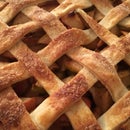Introduction: 3D Printed Geneva Gear
Breaking into new territory! I was looking for a project to practice Solidworks and assemblies in particular so I set out to find some mechanism I could use as a baseline for my model.
So what's a Geneva gear? The Geneva drive or Maltese cross is a gear mechanism that translates a continuous rotation into an intermittent rotary motion. The rotating drive wheel has a pin that reaches into a slot of the driven wheel advancing it by one step. The drive wheel also has a raised circular blocking disc that locks the driven wheel in position between steps. (Thanks Wikipedia!) Used in watchmaking originally and a pile of other things. I wonder, if more people tinkered with mechanisms earlier in school, where else this idea would crop up.
I saw others like this on Instructables and elsewhere, which were great inspiration. I wanted to create one that could stand up on its own, so this one has a small base to it as well.
Step 1: Sketch It!
Before modeling this in Solidworks, I set out to draw the underlying mechanism to understand the constraints. It's important to do this without tracing so your hand and brain do their homework.
My goal was to draw while thinking through relationships I knew I could establish in Solidworks and frame how the parts could be constructed. Putting the pencil to paper made me consider each part of this mechanism as I was drawing it. This is how I realized I wanted a base, thought about scale, considered tolerances, and how many supporting parts I needed to create.
Step 2: CAD It!
I started constructing the base first, then the drive wheel, then the driven wheel, and finally the two types of pins. I don't think there's one right order for developing this.
What I was most excited about in this process was to create a roughly dimensioned first pass of all the parts, mate them in the assembly, and use the assembly as a tool to see where I needed to make modifications. This proved quite successful!
All the files are attached here to make your own. I encourage you to have a go at this yourself and modify it to fit an application that piques your interest.
Step 3: Print It and Assemble!
You can send files like I had in the last step to 3D Hubs or a similar printing service if you don't have access to a 3D printer. I went that route this time, since I only occasionally have access to print things on my own.
Take the pieces, clean them up if necessary from any rafts, and assemble! It's important the pieces have a snug fit, but you might find the pins fit tighter or looser depending on your printer.
Step 4: Crank It!
Give your new Geneva Gear a spin!
If you've done everything properly, everything should spin freely as you turn the drive wheel. If not, the good news is you can swap out one piece at a time and experiment.
A note on printing: I've printed two identical versions of this with different filament and had different results. This seems to be the case with PLA filament. You might find you need to adjust the files slightly depending on your printer's special quirks.
In the end, this was a great learning experience for me and a great first project to get my feet wet with Solidworks assemblies. I'm not the most savvy at modeling in CAD (there are many of you who will read this with serious chops!) but gained a lot of confidence through this project and look forward to future experiments.

Participated in the
3D Printing Contest 2016

Participated in the
Beyond the Comfort Zone Contest





![Raised Bed Garden [for Those With Only Hand Tools!]](https://content.instructables.com/F2Q/UUXE/JUQSKGLC/F2QUUXEJUQSKGLC.jpg?auto=webp&crop=1%3A1&frame=1&width=130)








